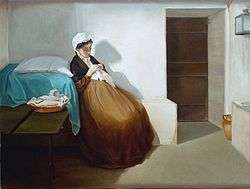Luisa Sanfelice
Luisa or Luigia Sanfelice (1764–1800) was an Italian aristocrat who was executed by Ferdinand I of the Two Sicilies because of her involvement with the French-backed Parthenopean Republic during the French Revolutionary Wars although Sanfelice was largely apolitical.[1] As she was generally regarded as the innocent victim of circumstances, she became a legendary figure who was widely portrayed in popular culture. During the nineteenth century she was often depicted as a gentle and naïve beauty whose story closely resembled that of the fictional Fioria Tosca, heroine of the Puccini opera Tosca.[2]

Amongst those who depicted Sanfelice was the French writer Alexandre Dumas who wrote the novel La San Felice (1864). In 1874 the artist Giovacchino Toma painted Luisa Sanfelice in Carcere, showing her in captivity before her execution. In the twentieth century Sanfelice appeared in two films Luisa Sanfelice (1942) and Luisa Sanfelice (2004).
Bibliography
- Lancaster, Jordan. In the Shadow of Vesuvius: A Cultural History of Naples. I.B.Tauris, 2005.
- Nicassio, Susan Vandiver. Tosca's Rome: The Play and the Opera in Historical Perspective. University of Chicago Press, 2002.
References
- Lancaster pp. 178–79
- Nicassio p. 117
External links
| Wikimedia Commons has media related to Luisa Sanfelice. |